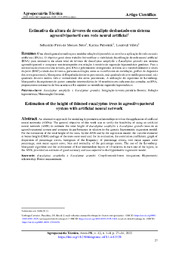Estimativa da altura de árvores de eucalipto desbastado em sistema agrossilvipastoril com rede neural artificial.
Estimativa da altura de árvores de eucalipto desbastado em sistema agrossilvipastoril com rede neural artificial.
Author(s): MORAES NETO, S. P. de; PULROLNIK, K.; VILELA, L.
Summary: Resumo: Uma abordagem alternativa para modelar relações hipsométricas envolve a aplicação de redes neurais artificiais (RNAs). O objetivo geral deste trabalho foi verificar a viabilidade da utilização de rede neural artificial (RNA) para estimativa da altura total de árvores de Eucalyptus urophylla x Eucalyptus grandis em sistema agrossilvipastoril e comparar seu desempenho em relação à modelo de regressão hipsométrico genérico. Para a estimativa da altura total das árvores, pela RNA e pelo modelo de regressão, utilizou-se a variável diâmetro à altura do peito (DAP) e idade das árvores e, para sua avaliação, usou-se o coeficiente de correlação, gráfico de dispersão dos erros percentuais, histograma de frequência dos erros percentuais, raiz quadrada do erro médio percentual, raiz quadrada do erro médio, viés e normalidade dos erros percentuais. A utilização do algoritmo de Levenberg-Marquardt e da arquitetura de quatro camadas intermediárias de 10 neurônios em cada uma das camadas, na RNA, proporcionou estimativa de boa acurácia e foi superior ao modelo de regressão hipsométrico. Abstract: An alternative approach for modeling hypsometric relationships involves the application of artificial neural networks (ANNs). The general objective of this work was to verify the feasibility of using an artificial neural network (ANN) to estimate the total height of Eucalyptus urophylla x Eucalyptus grandis trees in an agrosilvopastoral system and compare its performance in relation to the generic hypsometric regression model. For the estimation of the total height of the trees, by the ANN and by the regression model, the variable diameter at breast height (DBH) and age of the trees were used and, for its evaluation, the correlation coefficient, graph of dispersion of percentage errors, histogram of the frequency of percentage errors, root mean square error percentage, root mean square error, bias and normality of the percentage errors. The use of the Levenberg- Marquardt algorithm and the architecture of four intermediate layers of 10 neurons in each one of the layers, in the ANN, provided an estimate of good accuracy and was superior to the hypsometric regression model.
Publication year: 2024
Types of publication: Journal article
Unit: Embrapa Cerrados
Keywords: Eucalyptus Grandis, Eucalyptus Urophylla, Integração, Lavoura, Neural networks
Observation
Some of Embrapa's publications are published as ePub files. To read them, use or download one of the following free software options to your computer or mobile device. Android: Google Play Books; IOS: iBooks; Windows and Linux: Calibre.
Access other publications
Access the Agricultural Research Database (BDPA) to consult Embrapa's full library collection and records.
Visit Embrapa Bookstore to purchase books and other publications sold by Embrapa.

